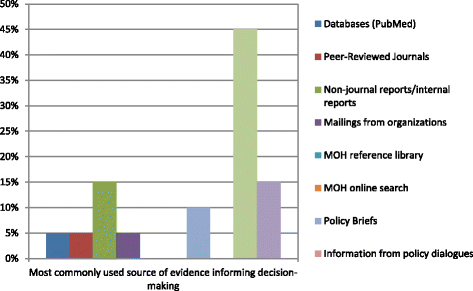Institutional capacity to generate and use evidence in LMICs: current state and opportunities for HPSR
- PMID: 29121958
- PMCID: PMC5680819
- DOI: 10.1186/s12961-017-0261-1
Institutional capacity to generate and use evidence in LMICs: current state and opportunities for HPSR
Abstract
Background: Evidence-informed decision-making for health is far from the norm, particularly in many low- and middle-income countries (LMICs). Health policy and systems research (HPSR) has an important role in providing the context-sensitive and -relevant evidence that is needed. However, there remain significant challenges both on the supply side, in terms of capacity for generation of policy-relevant knowledge such as HPSR, and on the demand side in terms of the demand for and use of evidence for policy decisions. This paper brings together elements from both sides to analyse institutional capacity for the generation of HPSR and the use of evidence (including HPSR) more broadly in LMICs.
Methods: The paper uses literature review methods and two survey instruments (directed at research institutions and Ministries of Health, respectively) to explore the types of institutional support required to enhance the generation and use of evidence.
Results: Findings from the survey of research institutions identified the absence of core funding, the lack of definitional clarity and academic incentive structures for HPSR as significant constraints. On the other hand, the survey of Ministries of Health identified a lack of locally relevant evidence, poor presentation of research findings and low institutional prioritisation of evidence use as significant constraints to evidence uptake. In contrast, improved communication between researchers and decision-makers and increased availability of relevant evidence were identified as facilitators of evidence uptake.
Conclusion: The findings make a case for institutional arrangements in research that provide support for career development, collaboration and cross-learning for researchers, as well as the setting up of institutional arrangements and processes to incentivise the use of evidence among Ministries of Health and other decision-making institutions. The paper ends with a series of recommendations to build institutional capacity in HPSR through engaging multiple stakeholders in identifying and maintaining incentive structures, improving research (including HPSR) training, and developing stronger tools for synthesising non-traditional forms of local, policy-relevant evidence such as grey literature. Addressing challenges on both the supply and demand side can build institutional capacity in the research and policy worlds and support the enhanced uptake of high quality evidence in policy decisions.
Keywords: Alliance for Health Policy and Systems Research; Health policy and systems research; Institutional capacity; Low- and middle-income countries.
Conflict of interest statement
Consent for publication
Not applicable.
Competing interests
ZCS, DJ and AG are Staff Members of the Alliance for Health Policy and Systems Research. Other authors declare that they have no competing interests.
Disclaimer
ZCS, DJ and AG are staff members of the World Health Organization. The authors are themselves alone responsible for the views expressed in this article which do not necessarily represent the views, decisions or policies of the World Health Organization.
Publisher’s Note
Springer Nature remains neutral with regard to jurisdictional claims in published maps and institutional affiliations.
Figures
Similar articles
-
Building the capacity of users and producers of evidence in health policy and systems research for better control of endemic diseases in Nigeria: a situational analysis.Global Health. 2019 Nov 21;15(1):69. doi: 10.1186/s12992-019-0530-6. Global Health. 2019. PMID: 31753038 Free PMC article.
-
Health policy and systems research and analysis in Nigeria: examining health policymakers' and researchers' capacity assets, needs and perspectives in south-east Nigeria.Health Res Policy Syst. 2016 Feb 24;14:13. doi: 10.1186/s12961-016-0083-6. Health Res Policy Syst. 2016. PMID: 26911836 Free PMC article.
-
An institutional approach to support the conduct and use of health policy and systems research: The Nodal Institute in the Eastern Mediterranean Region.Health Res Policy Syst. 2015 Oct 1;13:40. doi: 10.1186/s12961-015-0032-9. Health Res Policy Syst. 2015. PMID: 26428084 Free PMC article.
-
Understanding the state of health policy and systems research in West Africa and capacity strengthening needs: scoping of peer-reviewed publications trends and patterns 1990-2015.Health Res Policy Syst. 2017 Jul 12;15(Suppl 1):55. doi: 10.1186/s12961-017-0215-7. Health Res Policy Syst. 2017. PMID: 28722555 Free PMC article.
-
Embedding health policy and systems research into decision-making processes in low- and middle-income countries.Health Res Policy Syst. 2013 Aug 8;11:30. doi: 10.1186/1478-4505-11-30. Health Res Policy Syst. 2013. PMID: 23924162 Free PMC article. Review.
Cited by
-
Using health policy and systems research to influence national health policies: lessons from Mexico, Cambodia and Ghana.Health Policy Plan. 2023 Jan 6;38(1):3-14. doi: 10.1093/heapol/czac083. Health Policy Plan. 2023. PMID: 36181467 Free PMC article. Review.
-
Individual and institutional capacity-building for evidence-informed health policy-making in Iran: a mix of local and global evidence.Health Res Policy Syst. 2022 Feb 12;20(1):18. doi: 10.1186/s12961-022-00816-3. Health Res Policy Syst. 2022. PMID: 35151312 Free PMC article.
-
"Research ends with publication": a qualitative study on the use of health policy and systems research in Ethiopia.Health Res Policy Syst. 2024 Jan 2;22(1):1. doi: 10.1186/s12961-023-01091-6. Health Res Policy Syst. 2024. PMID: 38167041 Free PMC article.
-
Research use at the Ministry of Health in Burkina Faso: the decision-makers' perspective.Implement Sci Commun. 2021 Feb 17;2(1):22. doi: 10.1186/s43058-021-00126-9. Implement Sci Commun. 2021. PMID: 33597047 Free PMC article.
-
Community engagement in research addressing infectious diseases of poverty in sub-Saharan Africa: A qualitative systematic review.PLOS Glob Public Health. 2024 Jul 15;4(7):e0003167. doi: 10.1371/journal.pgph.0003167. eCollection 2024. PLOS Glob Public Health. 2024. PMID: 39008476 Free PMC article.
References
-
- World Health Organization. Sound Choices: Enhancing Capacity for Evidence-informed Health Policy. 2007. Green A, Bennett S (Eds.) http://www.who.int/alliance-hpsr/resources/publications/9789241595902/en/. Accessed 19 August 2015.
-
- Alliance for Health Policy and Systems Research. What is Health Policy and Systems Research and Why Does it Matter? AHPSR Briefing Note 1 2007. Geneva, World Health Organization. http://www.who.int/alliance-hpsr/resources/alliancehpsr_briefingnote1.pd.... Accessed 19 August 2015.
MeSH terms
Grants and funding
LinkOut - more resources
Full Text Sources
Other Literature Sources


